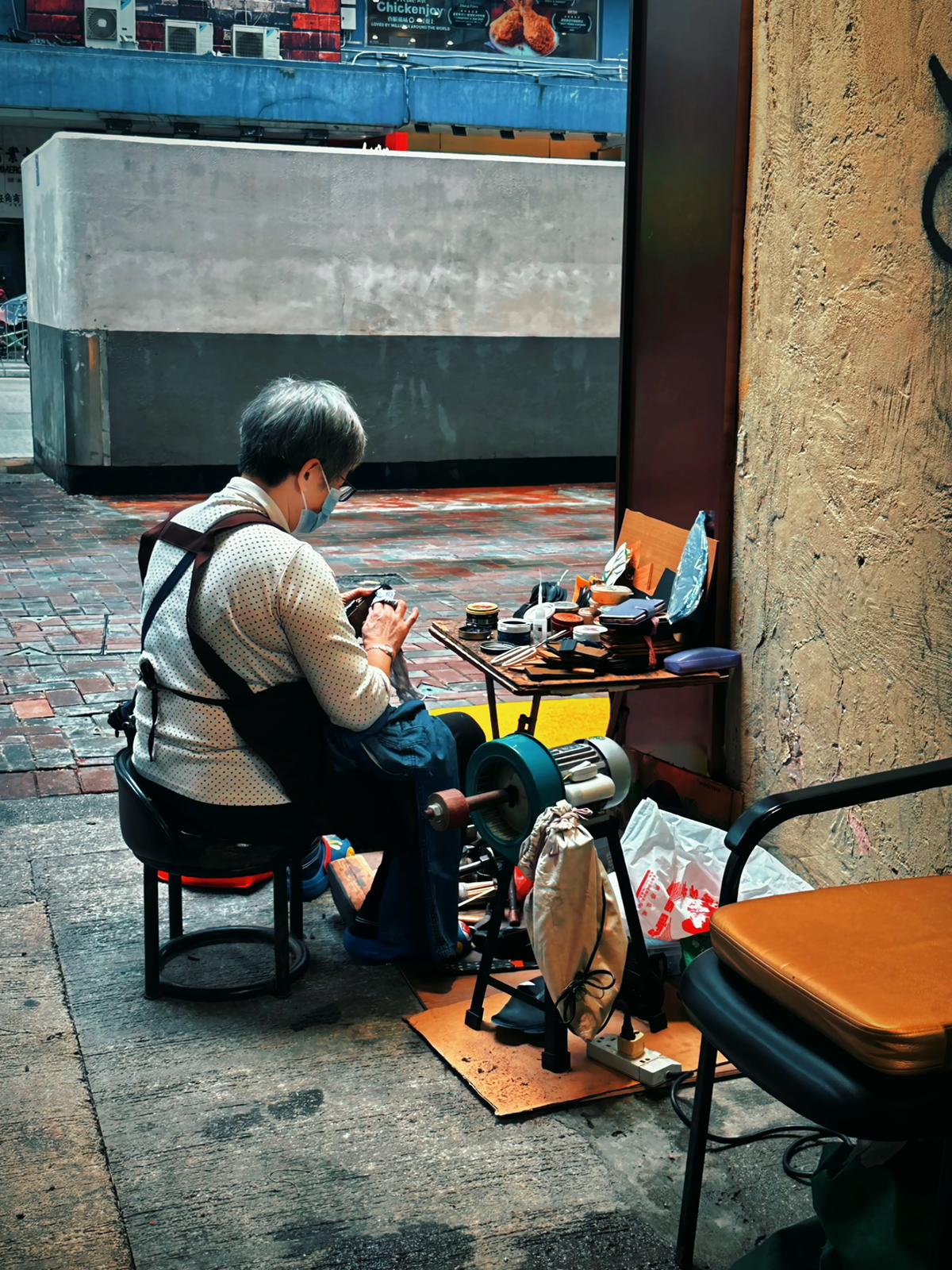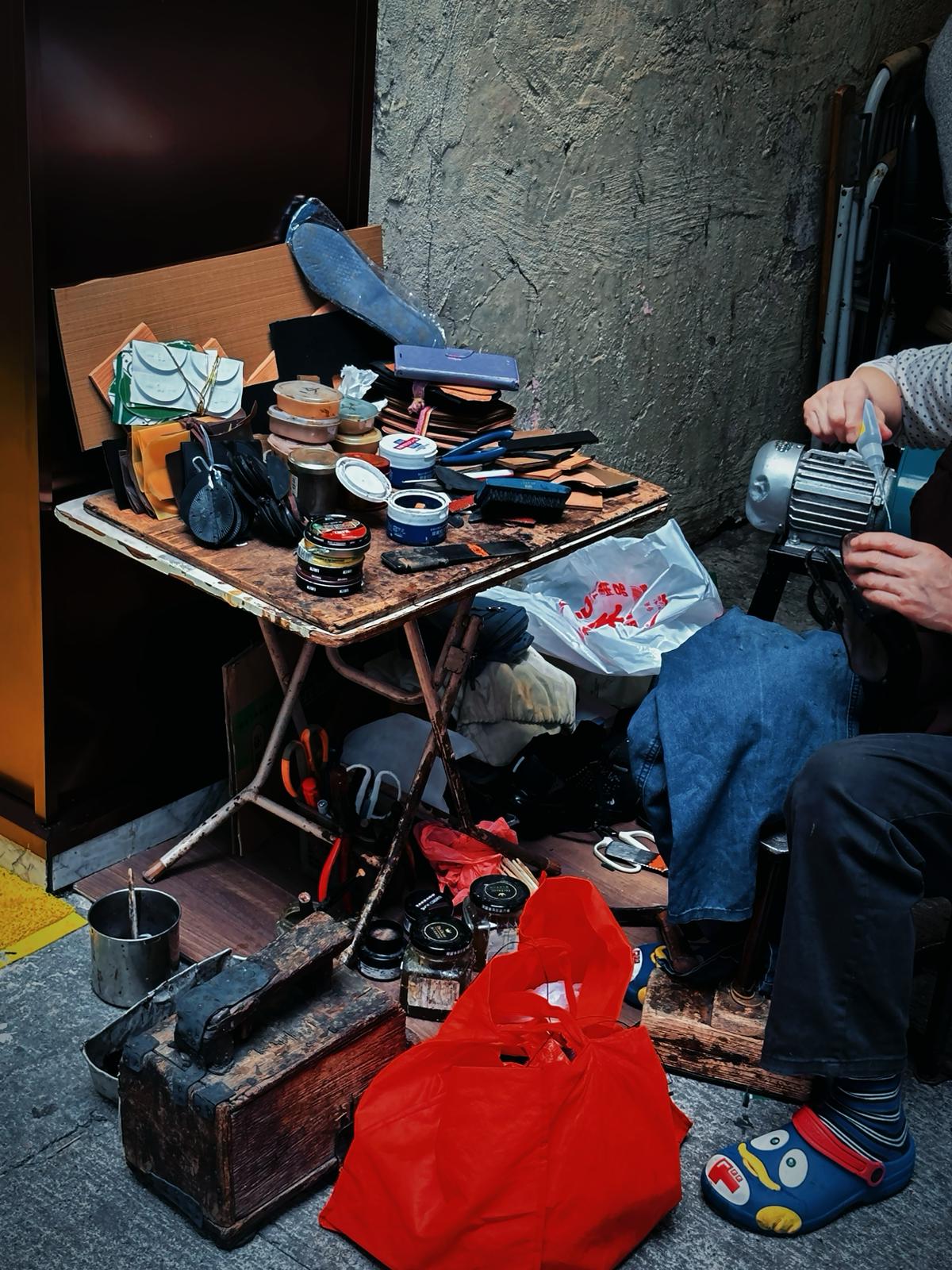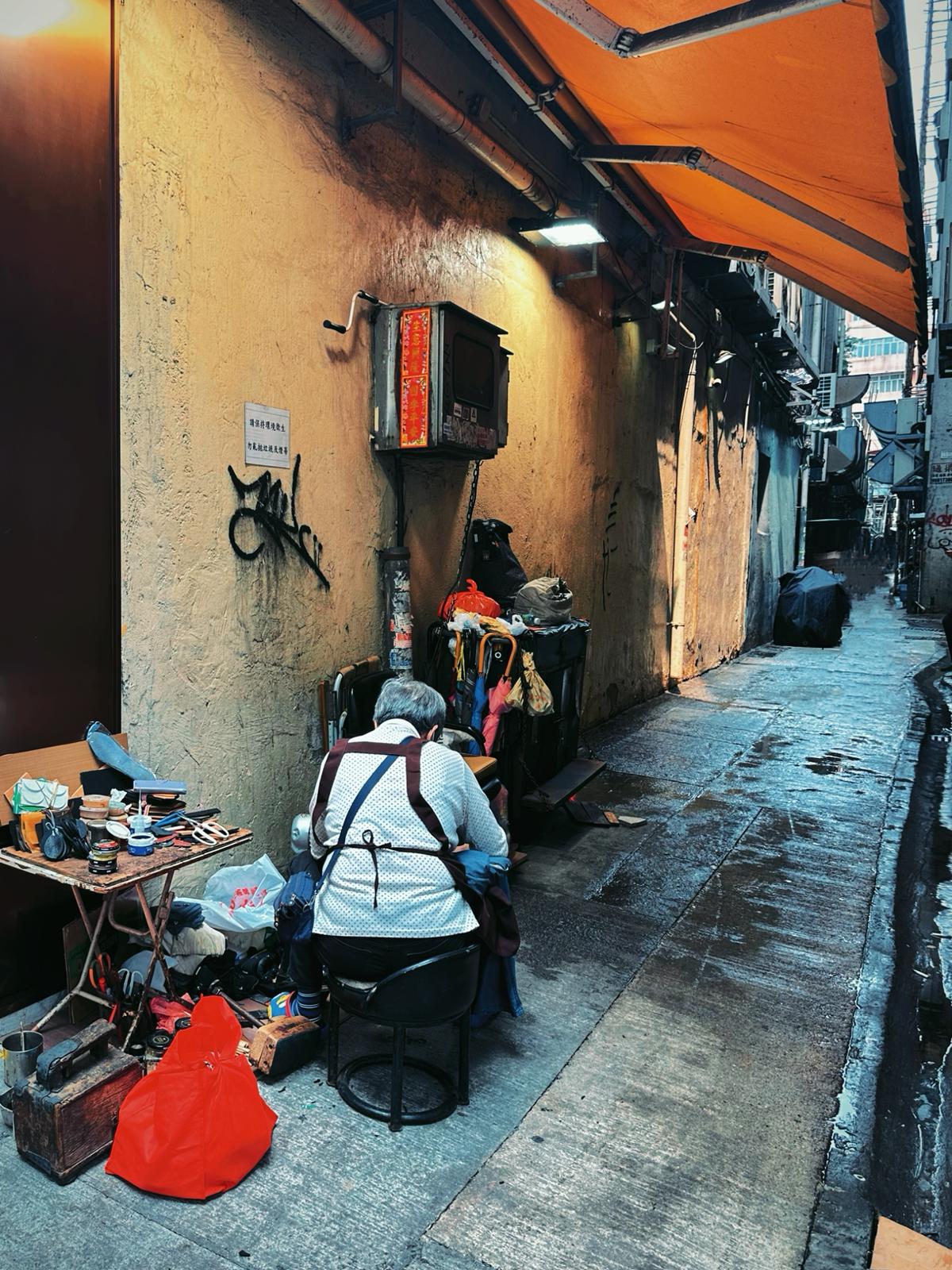Transcript:
Z: Hi I’m Xiong Na Zona!
I: Hi I’m Isabel!
Z: Isabel, did you manage to get your old shoes fixed?
I: Yes! I looked for a long time before I managed to find this shoe repair shop. It was situated in a small alley.

Z: I see this sign every time I walk past Mong Kok. I feel like this run-down repair shop seems out of place among the bustling streets.
I: Yes it does. But they did an excellent job despite their unassuming appearance.
Z: That’s great! I’ve been seeing these places less and less in Mainland. It’s amazing that we are able to find it in Hong Kong!
I: Truth to be told, I waited there for a long time but I was the only customer. These places seem to be disappearing in Hong Kong also.
Z: This traditional cobbling business has served the public for decades, repairing and maintaining footwear. I’m curious as to why they are disappearing.

I: I believe there are a lot of reasons. Firstly, The advancing age and retirement of the skilled cobblers led to less people knowing this craft. The current crop of skilled cobblers is reaching retirement age, and fewer young people are choosing this profession. Cobbling is an art form requiring considerable skill and patience, but it is often undervalued in a world that celebrates speed and convenience. With older cobblers stepping away, and no apprentices in sight, the expertise required for high-quality shoe repair is becoming scarce.
Z: I agree. Also, there’s the undeniable impact of consumer culture, where the lure of cheap prices often outweighs the appreciation for craftsmanship. The market has been flooded with inexpensive, mass-produced footwear, making the cost of repair seem excessive by comparison. For many, it’s easier to buy a new pair of shoes than to invest in repairing an old one. This shift in consumer behaviour has significantly reduced the demand for cobbling services.
I: I can’t agree more. We should also consider the issue of sustainability. The shoe repair business thrives in a culture that values long-term use over disposability. However, today’s shoes are not always made to be repairable, with the use of glues and materials that are not conducive to mending. This is a departure from the past, where shoes were often constructed with the possibility of repair in mind.
Z: Now I get it. I think this is also the reason why these places will not exist in the near future.
I: These places hold significant value though. Zona, what do you know about the past of shoe repair shops?

Z: Historically, the shop may have been a bustling hub, with a consistent flow of customers seeking repairs for well-loved shoes. It serves the purpose of not only repairing shoes but also as a community space where interactions take place and craftsmanship is appreciated.
I: You’re right! These traditional cobblers have often been pillars of the community, providing a gathering place for locals to share stories, exchange news, and connect with one another. The shop becomes more than just a repair service—it becomes a social hub where relationships are built and strengthened.
Z: Absolutely. It’s fascinating to imagine the shop as a focal point of the neighborhood, where people would gather and engage in conversations while waiting for their shoes to be fixed. These interactions foster a sense of belonging and create a shared identity within the community.
I: And let’s not forget the appreciation for craftsmanship that these cobblers embody. Their dedication to their trade and the meticulousness with which they handle each repair is a testament to their skill and expertise. People would often marvel at their ability to bring worn-out shoes back to life and extend their lifespan.
Z: That’s true. The shop’s reputation for quality workmanship would spread by word of mouth, attracting customers from far and wide. It’s not just about fixing shoes; it’s about preserving and prolonging the life of cherished footwear, creating a sense of value and sentimental attachment.
I: It’s interesting to think about how the shop has evolved over time. The changing dynamics of the community, advancements in technology, and shifts in consumer behavior have all influenced the shop’s operations and customer base. Adapting to these changes while maintaining the essence of traditional cobbling must have been a challenge for the owners.
Z: Indeed, the ability of the shop to adapt and stay relevant is crucial for its survival. Some cobblers have embraced new techniques and materials while still honoring the traditional aspects of their craft. They may offer additional services like customization or restoration of vintage shoes to cater to a broader range of customers.
I: It’s heartening to know that despite the challenges, there are still customers who appreciate the value of these cobblers’ work. Their loyalty and support contribute to the sustainability of the shop and help preserve the legacy of traditional cobbling in the community.

Z: It’s sad to see them go! Traditional cobblers who have spent their lives honing their craft will face the loss of their livelihoods and a decline in the recognition of their skills. Regular customers who rely on the services of shoe repair shops will also need to find alternatives or settle for less durable shoes.
I: Yes! There may also be a sense of nostalgia and loss among community members who value the history and cultural significance of these shops. Zona, do you know what have been done to preserve these places?

Z: There could be various levels of action or inaction regarding the shop’s disappearance. If the community deeply values the shop, there might be initiatives to preserve it, such as seeking heritage status, crowd-funding to keep it afloat, or looking for someone to continue the trade.
I: Yes. Alternatively, if the community does not value this art, there may be little to no action taken, with acceptance of the changing times and an unspoken acknowledgment that the shop has reached the end of its life cycle. Exploring any preservation efforts or the lack thereof will reveal cultural and social values in relation to such spaces.
Z: It’s understandable, but it’s still a loss for our cultural heritage. The atmosphere of the cobbler’s shop itself is an endangered one. People once valued the personal connection with artisans in their communities. The shop was a place of rapport and storytelling, where customers felt a kinship with the craftsperson. These cobblers have been an integral part of our communities, passing down their knowledge and skills through generations. Their disappearance not only affects the availability of repair services but also diminishes the sense of tradition and craftsmanship in our society.
I: Absolutely. It’s important to acknowledge and preserve these traditional trades and crafts. While it may be challenging to reverse the decline, efforts can be made to raise awareness about the value of traditional cobblers and support their businesses. This could include campaigns, collaborations with fashion designers for unique shoe designs, or even incorporating traditional cobbling techniques into modern shoe manufacturing.
Z: That’s a great idea! By promoting the uniqueness and artistry of traditional cobbling, we can encourage people to appreciate and seek out their services. It would be a shame to lose these skilled artisans and the cultural richness they bring.
I: I couldn’t agree more. Let’s do our part in spreading awareness and supporting these traditional cobblers. Perhaps by doing so, we can help ensure that their craft continues to thrive and be appreciated by future generations.
Z: This is the end of our podcast. Thanks for your time!
E: Bye everyone!
Chan Wing Sum Isabel- 3036270429
Na Xiong Zona-3036260345